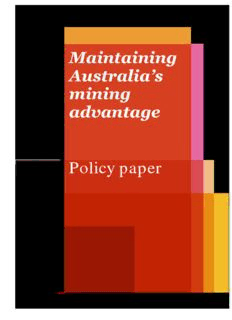
Maintaining Australia's advantage: mining advantage policy paper PDF
Preview Maintaining Australia's advantage: mining advantage policy paper
This report can be found at www.acola.org.au © Australian Council of Learned Academies www.pwc.com.au Maintaining Australia’s mining advantage Policy paper TheAustralianCouncil ofLearnedAcademies July2014 This report can be found at www.acola.org.au © Australian Council of Learned Academies Contents 1 Introduction 1 2 Australia’sminingsector 2 3 Comparativeadvantages&disadvantages 8 4 Lookingtothefuture 16 5 Keyfindings 25 6 PolicySolutions 31 AppendixA CurrentissuesforAustralianmining 47 AppendixB Sources 52 i Miningpolicypaper: MaintainingAustralia’sminingcomparativeadvantages This report can be found at www.acola.org.au © Australian Council of Learned Academies 1 Introduction 1.1 Overview PricewaterhouseCoopers(PwC)hasbeenengagedbyTheAustralianCouncilofLearned Academies(ACOLA)tocompilearesearchreportonAustralia’sminingsector.Specifically, thisreportexaminesAustralia’scomparativeadvantageinminingthroughunderstanding thecurrentminingsectoranditschallenges,sourcesofcomparativeadvantage,andcredible viewsofpossiblefuturesandforecastsforthesector. Requirementsforthesectortomaintainitscomparativeadvantageandaddressthe challengesareaddressedandalternativestrategiesforAustraliainthefutureareidentified anddiscussed. 1 Miningpolicypaper: MaintainingAustralia’sminingcomparativeadvantages This report can be found at www.acola.org.au © Australian Council of Learned Academies 2 Australia’s mining sector Forthepurposesofthisreport,miningisconsideredtobetheaction,process,orindustryof extractingoresandothermaterialsfrommines.Insomeinstances,thefirststageof processing,knownasprimaryprocessing,isincluded.Examplesofprimaryprocessinginclude therefiningandtransformationoforestobasicformssuchasmetals. Thefocusofthissectionismainlyonores.However,whenappropriate,theanalysisalso includesthebroaderindustrysuchasprocessing,andassociatedindustriessuchasservices, infrastructure,andmanufacturingofwhichsupporttheminingindustry.Abrieflookisalso providedonthegasindustryduetotheabundanceofgasinAustralia,highlevelsof investment,andthegrowthofgasusageinternationally. Theinformationthatfollowsregardsthesize,growthandinvestmentoftheminingindustry andananalysisofthecurrentissuesfacingtheindustry.Wherepossible,theinformationthat isconsideredinthisreportisfromprimarysourcessuchastheAustralianBureauofStatistics andcrediblesecondarysourcessuchasGeoscienceAustralia,Marketline,BureauofResources andEnergyEconomics,IBISWorld,andBusinessMonitorInternational.Wenotethatin somecasesthe‘sector’isdefineddifferentlydependingonthesource. 2.1 Size and growth TheminingindustryislargeandcriticallyimportanttotheAustralianeconomy.Itisnotonly largeintermsoforesextractedandmined,butisalsopartofalargervalueaddedindustry whichincludesprocessing,andassociatedservices. Informationisavailableonthefollowingsectors/industriesinAustralia:oreresourcesinthe groundwhichareaccessibleformining,actualresourcesmined,miningaswellasmetal production,thetotalminingindustryincludingextraction,processingandservices,minerals exported,andthegasandoilextractionindustry. Table1attemptstosummarisesector revenueandgrowthprojectionswithinthiscontext. Table1:Australianminingsector–sizeandgrowth SECTOR REVENUE GROWTHIN COMMENTS 2013 REVENUE ($b) (%perannum) Miningextraction1 90.32 4.3From2012to Oremined. 2017 Miningextraction 121.94 11.0 From2011to Oremined,andproduction andmetals 2016 ofmetalssuchas production3 Aluminium,Iron,Steel. Mineralsandore 130.0 Ironore$82.1billion, exported5 metallurgicalcoal$23.7 billion,thermalcoal$17.2 billion. Oilandgas 56.0 16.0From2013to 37%onthevolumeofgas 1GeoscienceAustralia(1,2) 286.6in2012 3Marketline(3) 498.9in2011 5 BureauofResourcesandEnergyEconomics(4) 2 Miningpolicypaper: MaintainingAustralia’sminingcomparativeadvantages This report can be found at www.acola.org.au © Australian Council of Learned Academies Australia’sminingsector extracted6 2018production producedisexported. (supply);9.0for industrysales (demand) Mining,andoiland 244.0 3.8From2013to Includesmining,oilandgas, gas,including 2018 ironsmeltingandsteel extraction, manufacturing;fossilfuel production,and electricitygeneration,gas services7 supply;electricity,gas,water andwasteservices; wholesaletradewhoprovide accesstomachineryand equipment;business services;andintegrated logistics. ThefindingshighlightedinTable1suggestthatAustralia’sminingindustryislargelyan ‘explore,extractores,producemetalsandexport’sector,butwithasignificantsupporting servicesector. Australiaalsohasmajorglobalcompanieswhichoperateintheminingandgassector,having fivecompaniesintheForbesGlobal2000list,withrevenueofabout$82billionperannum. Thesefivecompaniesare:BHPBilliton,WoodsidePetroleum,Santos,FortescueMetals,and NewcrestMining. IdentifiedandexploitedmineralresourcesinAustralia EconomicDemonstratedResources(EDR)arethoseknownresourcesinthegroundthatare accessibleformining.ResearchsuggeststhatasatDecember2011,Australia’sEDRofa numberofminerals(suchasironore)aretheworld’slargest.8 ThemineralsindustryisAustralia’slargestexportearnerwithmineralexportsaccountingfor 50%to60%oftheannualvalueoftotalexportsofgoodsandservices.Australia’sminerals industryisdominatedbycoal,ironore,alumina/aluminium,copper,nickelandgold,with principalmarketsinChina,Japan,SouthKoreaandIndia.Thevalueofthesectorisexpected toreach$107billionby2017from$86.6billionin2012,growingatanannualaveragerateof 4.3%overthisforecastperiod.9 MiningandmetalsproductioninAustralia Themetalsandminingindustryconsistsof:aluminium,ironandsteel,preciousmetalsand minerals,coalandbasemetals.Further,thisincludesmining(extractionfromtheground)as wellasproductionofmetalssuchasaluminium,leadandsteel.TheAustralianminingand metalsindustryin2011was$98.9billion,withforecastsconductedin2011suggestingthatit wouldreach$169.4billionin2016(11%perannumgrowth)withvolumeonlyincreasingby about1%perannumoverthisperiod,from412.2mmtto436.5mmt.10Itisimportanttonote however,thatthisrevenuegrowthforecastof11%perannumwasmadein2011when commoditypriceswereincreasing.Consequently,oneneedstotakethisforecastgrowthwith cautionascommoditypriceshavedecreasedsince2011(seeTable2). 6IBISWorld(5) 7IbisWorld(6) 8GeoscienceAustralia(1,2) 9BusinessMonitorInternational(7) 10Marketline(3) 3 Miningpolicypaper: MaintainingAustralia’sminingcomparativeadvantages This report can be found at www.acola.org.au © Australian Council of Learned Academies Australia’sminingsector Coalisthelargestsegmentaccountingfor52.3%oftheindustry’stotalvalue.Australia accountsfor5.1%oftheAsia-PacificminingandmetalsvaluewithChinaat72.4%(Asia- PacificalsoincludesJapan,SouthKorea,andNZamongstothers). Miningindustryincludingextraction,processingandservices Thescopeoftheminingindustryincludesalloperationsmainlyengagedintheextractionof mineralsandhydrocarbons(oilandgas),explorationformineralsandhydrocarbonsandthe provisionofavarietyofservicestofirmsengagedintheseactivities.Industriesinvolved include:mining;ironsmeltingandsteelmanufacturing;fossilfuelelectricitygeneration,gas supply;electricity,gas,waterandwasteservices;wholesaletradewhoprovideaccessto machineryandequipment;businessservices;andintegratedlogistics. Theindustryisexport-oriented,withexportsexpectedtoaccountforover65%ofrevenuein 2013.Thiscomparesto50%to60%growthinminerals,implyingahigherexportperformance fordownstreamactivities.Performancedependsonglobaltrendsinsupplyanddemandfor commodities.Revenuewas$244.4billionin2013andisexpectedtogrowatacompound annualrateof3.8%overthenextfiveyears.11 GasextractioninAustralia Australiaisendowedwithsignificantgasresourceswitharound3.8trillioncubicmetresofgas EDR.However,theiruseinAustraliahashistoricallybeenovershadowedbycoal,especiallyin thepowersector.Gashasgrowninimportanceoverthelastdecadewithgasnowrepresenting themajorityofnewelectricitygenerationinvestment.Assuch,gasdemandgrowthhasbeen fasterthanotherfossilfuels,andgasisnow21%ofAustralia’senergysupply.12 Australia’stotalgasproductionin2012/13wasestimatedtobe59billioncubicmetresof whichLNGexportswerearound36%ofAustralia’sgasproduction.ExportsofLNGhave increasedstronglyinrecentyears.Indeed,overthepastfiveyearsasnewLNGprojectshave beencommissionedinresponsetogrowinginternationaldemandgrowthof8%%perannum hasresulted.In2012,around79%ofAustralia’sLNGexportsweresoldtoJapanand16%to China.13 Industryperformanceisexpectedtoimprovedramaticallyoverthenextfiveyearsfrom2013 inresponsetorisingproduction(especiallynaturalgas)andhigherpricesforoilandgas. Increasedinvestmentintheindustrywillsupportrisingoutput.Industryproductionis forecasttoexpandatacompoundannualrateof16.0%overthenextfiveyears,toreach$101 billionin2018from$56billionin2013.14Thisisduetoongoinginvestmentingasextraction andnewsourcescomingonline.ThisincreasedproductionisduetodemandforLNG increasingasanenergysourceinternationallyasacost-effectivealternativeasoilreserves dwindleandbecomemoreexpensiveanddifficulttoaccess.Industrysalesrevenueisforecast toincreaseby9%over2013onthebackofincreasednaturalgasoutputasmajorinvestments comeonstream(forexample,Chevron’sGorgongasprojectin2015). Australiaalsohasalongertermopportunitytoexploitshalegasasconcludedinastudyofthe AustralianCommitteeofLearnedAcademies(ACOLA).Thereportnotesthat“shalegashas thepotentialtobeaneconomicallyveryimportantadditionalenergysource.” 11IbisWorld(6) 12BureauofResourcesandEnergyEconomics(8) 13Ibid 14IBISWorld(5) 4 Miningpolicypaper: MaintainingAustralia’sminingcomparativeadvantages This report can be found at www.acola.org.au © Australian Council of Learned Academies Australia’sminingsector 2.2 Mining investment MininginvestmentinAustraliafrom2002to2012hasbeenhigh,andhasbeenamajordriver ofeconomicgrowth. Mininginvestmentwas7.7%ofAustralia’sGrossDomesticProduct (GDP)attheendof2012risingfrom1.5%ofGDPadecadeago.15Themajorreasonforthe investmentincreasewassoaringdemandfromAsianeconomies,particularlythatofChina. By2013however,mininginvestmentpeaked.TheBureauofResourcesandEnergyEconomics believethatinlate2013,$150billionofhighvalueprojectsthatwereatthefeasibilitystage havebeendelayedorcancelledsinceApril2012.IntheOctober2013listingtherewere63 projectsattheCommittedStagewithacombinedvalueof$240billion,comparedwith73 projectswithacombinedvalueof$268billionsixmonthsearlier.Thisvalueispredictedto fallto$70billionbytheendof2017.Iftheseforecastsarecorrect,thepeakininvestment passedinOctober2012,when$268.4billionwascommittedtoprojects.16 Theviewisthatamininginvestmentdeclinewilloccurfrom7.7%ofGDPin2012to5.5%of GDPby2016,fallingbelow4%ofGDPby2023.17 Intheir2013-14Budgetdocuments, FederalTreasuryseeamodestdeclineinmininginvestmentin2014-15,withsharperfallsover 2015-16and2016-17.Thereasonsforapeakingandforecastdeclineinmininginvestment include:18 Risingcosts,decreasingproductivityandmoreregulationandtaxesofwhichare punishingtheindustry Adeclineincommoditypricesgloballyasthesupplyofcommoditiescatchupto,and insomecasesexceed,thedemandforthesecommodities ThisinvestmentdeclineisevidencedbyBHPBillitonwhohaveannouncedareductionin capitalandexplorationexpenditurefromUS$21.7billionin2013toUS$16.2billionin2014 andthefocuswillmovetogeneratingmorevolumefromexistingequipmentandthelowering ofunitcosts.19Similarly,RioTinto’scapitalexpenditurehasbeenreducedby26%toUS$12.9 billionin2013,comparedtothepeaklevelin2012ofUS$17.6billion.Itisexpectedtobe reducedfurthertoaroundUS$11billionin2014. “Intoday’scapital-constrainedenvironment,onlythehighest-returninginvestmentswillbe approved.TheGroupanalyseseachinvestmentbasedonnetpresentvaluebutalsoconsiders anumberoffurtherfactors,includinginternalrateofreturn,paybackperiodandrisk profile.Thissuiteofrankingcriteria,togetherwiththeapplicationofstrategicjudgment, ensuresthatcapitalisdeployedtothebestopportunities.Ourresponsetothishasbeento focusoncosts,cashflowandcapitaldiscipline.Othersinthesectorhaveembarkedupon similarpaths.Inefficienciesarealsobeingexposed,andsoreductionsincostsandcapital expenditure,productivityimprovements,andprojectdeferralsandcancellationshave becomeaprominentpartofminingindustrystrategy.”(RioTinto,AnnualReport2013) Table2summariseschangesintheindexofbasemetalcommoditypricesoverthepast20 years.TheindexisbasedoninformationsuppliedbytheReserveBankofAustralia(RBA)who useaweightedbasketofcurrencies(US$,Euro,Yen,andUK£)establishedbythe InternationalMonetaryFund(IMF)toestablishprice(andknownas‘SpecialDrawingRights’ orSDR).Itisquiteclearthattherewasamajorincreaseinbasemetalpricesuntil2011,anda steadydeclineuntilMarch2014. 15DeloitteAccessEconomics(9)andRBA(10) 16MiningCouncilofAustralia(11)andBureauofResourcesandEnergyEconomics(12) 17DeloitteAccessEconomics(9) 18MiningCouncilofAustralia(11);DeloitteAccessEconomics(9)andBureauofResourcesandEnergyEconomics (12) 19MiningCouncilofAustralia(13)andBHPBilliton(14) 5 Miningpolicypaper: MaintainingAustralia’sminingcomparativeadvantages This report can be found at www.acola.org.au © Australian Council of Learned Academies Australia’sminingsector Table2:RBAindexofbasemetalcommodityprices DATE March March March March March March March March 1995 2000 2005 2010 2011 2012 2013 2014 PriceIndex 55.8 56.0 75.2 107.9 123.9 108.1 100.6 90.2 (2012/13=100) Source:RBA(March2014)Indexofcommodityprices TheBureauofResourcesandEnergyEconomicshavestatedthatAustraliaisnowseeinga transitionfromtheinvestmentphaseoftheresourcesboomtotheproductionphaseasnewly developedprojectscommencecommercialproduction.Theprojectscompletedin2012and 2013“haveaddedconsiderablytoAustralia’sproductioncapacityandwillsupportstrong commodityexportvolumesintothefuturewithalastingimpactontheAustralianeconomy.”20 Section4examinesscenariosforpotentialfuturetrendsformininginvestmentinAustralia. 2.3 Current issues and analysis AnumberofcurrentissuesandchallengesarefacedbytheAustralianminingindustry.These areshowninAppendix1.ThedetailedinformationinAppendix1(withsources)canbe summarisedasaSWOTanalysis(Strengths,Weaknesses,Opportunities,andThreats)as shownbelowinFigure1.Forfurtherelaboration(andsources)pleaserefertoAppendix1. Figure1:AustralianminingsectorSWOTanalysis 20BureauofResourcesandEnergyEconomics(12) 6 Miningpolicypaper: MaintainingAustralia’sminingcomparativeadvantages This report can be found at www.acola.org.au © Australian Council of Learned Academies Australia’sminingsector 7 Miningpolicypaper: MaintainingAustralia’sminingcomparativeadvantages This report can be found at www.acola.org.au © Australian Council of Learned Academies 3 Comparative advantages & disadvantages ThissectionexplorestheAustralianminingsector’ssourcesofcomparativeadvantageand considerswhetherAustraliahastheabilitytomineoresandproducemineralsmore advantageouslythanothercountries.Thiswouldconsideraspectsoflowercost,greater reliability,andlowerrelativerisk.Inaddition,viewsaresummarisedonwhetherthe comparativeadvantageissustainable,andtherequirementstomaintaintheadvantage. 3.1 Current mining comparative advantage Comparedwithmanycountries,Australiahasacomparativeadvantageintheproductionof mineralcommodities.21Thisstemsfromarangeoffactorsincluding: Arichanddiversemineralendowment Highquality,regional-scalegeoscienceinformationwhichlowerstherisksof exploration Advancedexploration Miningandprocessingtechnologies Askilledworkforce Generallybenignphysicalconditionsandlowpopulationdensity. Thesefactorsmeanthatmodernminingcanbeundertakeninlinewithincreasing communityexpectationsforenvironmentalandsocialperformance. Inrecentdecades,improvementsinminingtechniques(includinglarge-scalemining equipmentandautomation)havereducedminingcostsandallowedeconomicextractionof depositsthatwerepreviouslyuneconomic.Newmetallurgicaltechniquesandbreakthroughs (suchascarbon-basedleachingtechnologiesforgolddeposits)haveimprovedtherateof recoveryforcertainmetalsandmineralsorenhancedtheeconomicviabilityofotherdeposits (suchaslateriticnickel)resultinginmajorincreasesintheseeconomicresources. AsatDecember2011,Australiahadtheworld’slargesteconomicresourcesofgold,ironore, lead,rutile,zircon,nickel,uraniumandzinc.Thecountryalsoranksamongthetopsix worldwideforknownresourcesofantimony,bauxite,blackcoal,recoverablebrowncoal, cobalt,copper,diamond,ilmenite,lithium,manganeseore,niobium,silver,tantalum, tungstenandvanadium.Australiaistheworld’sleadingproducerofrutile,zircon,bauxite andalumina,thesecondlargestproducerofgold,ironore,lithium,manganeseore,leadand zinc,thethirdlargestproducerofilmeniteanduranium,andthefourthlargestofsilver, nickelandblackcoal. Australia'smineralresourcesareadequateforminingtocontinueasthemostimportant exportearningsectoroftheAustralianeconomyfortheforeseeablefuture.Foragiven resource,ratiosofEDRtocurrentmineproductionprovideindicativeestimatesofthe resourcelife.Usingtheseratios,weseethattheEDRofmostofAustralia’smajor commoditiescansustaincurrentratesofmineproductionformanydecades.Commodities 21GeoscienceAustralia(1,2) 8 Miningpolicypaper: MaintainingAustralia’sminingcomparativeadvantages
Description: